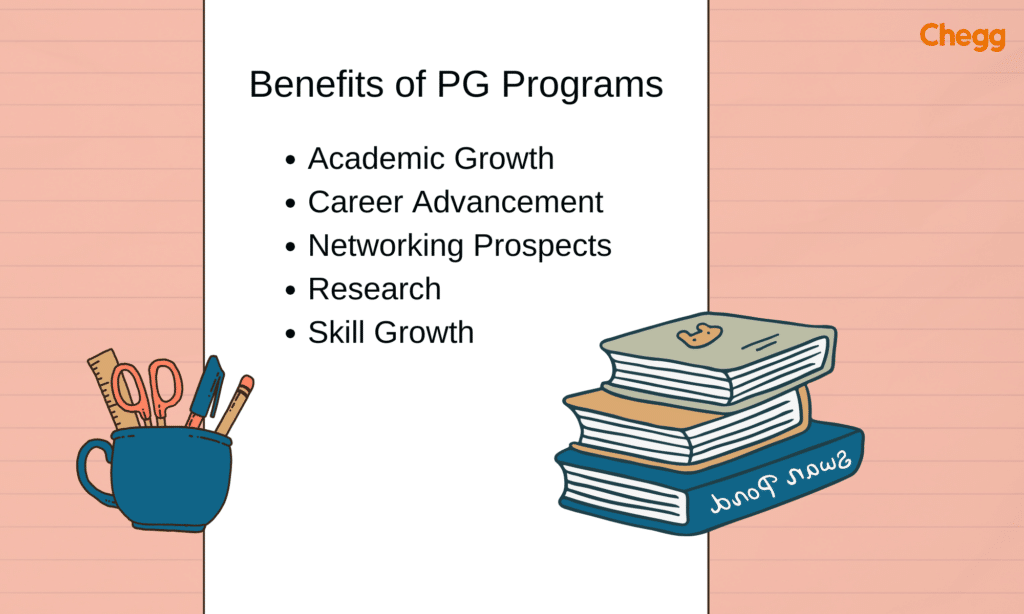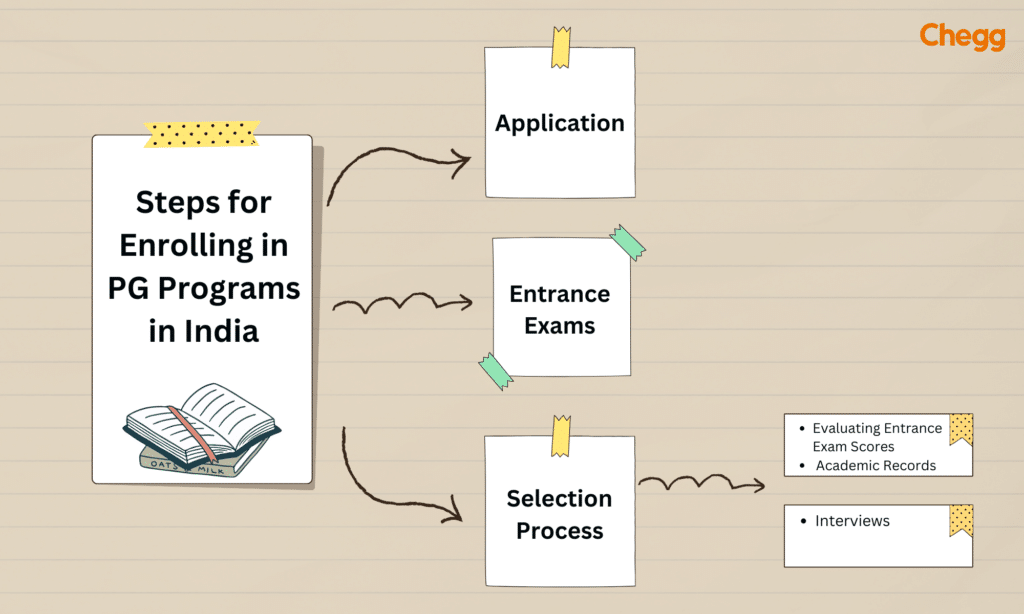Home » Full Forms » PG Full Form: Benefits and Some Popular PG Programs
PG Full Form: Benefits and Some Popular PG Programs

Table of Contents
PG Full Form
In today’s era, PG holds great significance. PG full form expands into Postgraduate, indicating the degree one can pursue after graduation. It is a master’s or advanced degree. After earning a bachelor’s degree, one can study further to become a postgraduate.
PG programs offer students in-depth knowledge and expertise in their chosen fields. The average salary of a postgraduate in India is Rs. 4 Lakh per annum. Want to pursue this lucrative course? Read this article to understand all about the master’s program in India.
What is PG Full Form?
Have you ever wondered what is the full form of PG? The PG full form is “Postgraduate.” It signifies educational programs that individuals can pursue after completing their undergraduate degrees. These programs need a high commitment to critical thinking compared to undergraduate studies.
The duration of these programs depends on the specific course and institution. PG programs in India generally span from one to two years. One must research the individual programs to determine their duration and requirements.
Difference Between PG and PGDM
Before we explore the key differences between the two, let’s understand the full form of PG Diploma (PGDM). PGDM is a diploma program focused on management studies. Its Full form is a Post Graduate Diploma in Management.
Some of its specifications are:
- It offers industry-specific management skills and knowledge.
- The duration of PGDM programs is two years.
- They prepare students for leadership roles and develop their managerial skills.
- PGDM programs emphasize practical learning and the application of management principles.
- Eligibility for PGDM programs usually requires a bachelor’s degree in any discipline.
- These programs provide career opportunities in various sectors, in managerial positions.
- PGDM admissions are merit-based. Students need to clear the entrance exams to pursue the course. Some of the popular exams are CAT, MAT, and CET.
- It is recognized by the All India Council for Technical Education (AICTE) and The Association of Indian Universities (AIU).
Some of the Key Differences between PG and PGDM are:
| Criteria | PG | PGDM |
| Degree | PG offers a master’s degree | PGDM awards a diploma. |
| Focus: | PG programs are more academic and research-oriented | PGDM emphasizes management skills. |
| Curriculum: | PG programs have a theoretical and practical curriculum. | Meanwhile, PGDM places greater emphasis on management principles |
| Career Scope | PG degrees provide a diverse range of career options. | PGDM programs aim at managerial roles. |
| Authorization: | All universities recognize PG programs. | AICTE and AIU-accredited universities offer PGDM programs. |
| Eligibility | PG programs need a bachelor’s degree in a relevant field. | PGDM programs accept graduates from any discipline |
| Entrance Exams | Some PG programs may need entrance exams. | For PGDM programs, exams like CAT or MAT are a must. |
Benefits of PG Programs and Enrollment Process
PG programs offer many benefits to students seeking advanced education. Here are some advantages of earning a postgraduate degree:

Academic Growth
PG programs provide in-depth knowledge of the chosen field. Through this course, students gain specialized knowledge and expertise.
Career Advancement
A postgraduate degree provides better career prospects. Along with higher job duties, this course increases earning potential.
Networking Prospects
Students get to engage with like-minded individuals. Fostering valuable connections leads to fruitful collaborations and career growth.
Research
Many postgraduate programs emphasize research. They enable students to contribute to their field through independent research projects.
Skill Growth
PG programs improve several valuable skills needed in the professional domain.
Global Opportunities
Certain postgraduate programs provide students with global exposure using exchange programs or partnerships with foreign universities, which widens their perspectives.
Career Change
By offering the information and abilities required for a smooth transition into new sectors or industries, postgraduate programs can help people change careers.
Steps for Enrolling in PG Programs in India
Here is how you can enroll in a PG program in India:

1. Eligibility
A Bachelor’s degree in the relevant field is necessary for PG programs. Students must check the eligibility criteria for the desired PG program.
2. Application
Submit the application form and enter all the required personal and academic details.
3. Entrance Exams
Some programs may need entrance exams. These exams help to assess the student’s aptitude and subject knowledge.
4. Selection Process
Many criteria determine the student’s final selection. Institutions admit candidates after evaluating entrance exam scores, academic records, and interviews.
Popular PG Programs in India
There are many popular PG programs in India. Here is a table describing different PG programs along with their duration.
| Name | Duration | Study Stream |
| Master of Business Administration (MBA) | 2 years | Management |
| Master of Science (M.Sc.) | 2 years | Science |
| Master of Technology (M.Tech) | 2 years | Engineering |
| Master of Arts (M.A.) | 2 years | Humanities |
| Master of Computer Applications (MCA) | 2 years | Computer Science |
| Master of Commerce (M.Com) | 3 years | Commerce |
| Master of Laws (LLM) | 2 years | Law |
Let’s understand each program in detail.
Master of Business Administration (MBA)
It prepares students for leadership roles in various industries. MBA graduates can become HR managers, Finance managers, or Marketing Managers. IIMs are the most renowned MBA colleges in India.
Master of Science (M.Sc.)
This postgraduate program offers specialization in diverse scientific fields. It provides students with advanced research. Students can become research scientists, data analysts, and professors.
Master of Technology (MTech)
This program caters to the engineering field. Graduates can pursue careers as engineers, researchers, and project managers.
Master of Arts (MA.)
The program offers specialization in humanities subjects, including literature, history, sociology, and more. Graduates can pursue careers as writers, journalists, teachers, or researchers.
Master of Computer Applications (MCA)
MCA focuses on computer science and applications. It prepares students for software engineering, data science, and IT management roles.
Master of Commerce (M.Com)
It teaches commerce and finance-related subjects. Students study accounting, financial analysis, and auditing skills. Later, graduates can pursue careers as accountants, financial analysts, or auditors.
Master of Laws (LLM)
The LLM program provides legal studies. It covers areas such as constitutional law, corporate law, or international law. Graduates can pursue careers as lawyers, legal advisors, or judges.
Conclusion Pursuing a postgraduate (PG) program offers many benefits. Students avail academic growth, career advancement, and skill development. They provide a platform for advanced study into specific fields of study. These programs also improve research capabilities.
Conclusion
In conclusion, enrolling in a postgraduate program (PG full form) has many benefits. Through these programs, students can grow in their careers, improve their academic performance, and develop new skills. They greatly improve in the development of research skills and provide a useful forum for in-depth investigation of specialized fields of study.
If you want to learn about other topics along with the BA full form click the links given below:
| BE Full Form | BHMS Full Form |
| PGDCA Full Form | JEE Full Form |
| DCA Full Form | B.com Full Form |
| BMS Full Form | EVS Full Form |
| PO Full form | LLB Full Form |
PG Full Form: FAQs
PG full form is “Postgraduate,” indicating educational programs pursued after undergraduate studies.
PG full form is “Postgraduate” This postgraduate term covers everything from “Postgraduate Diploma” to “Master’s Degrees” to “Doctoral degrees”
Yes, you can do that. The eligibility criteria for a Diploma in any stream is a 10th pass. But for the lateral entry after the 12th, you must have PCM.
Depending on the specific course and institution, PG programs’ duration can range from one to two years.
PG refers to postgraduate programs offered by universities. PGDM stands for Post Graduate Diploma in Management. Autonomous institutes or business schools offer it.
Eligibility criteria vary among institutions. Applicants should hold a recognized undergraduate degree in a relevant field.
Many PG programs need applicants to clear entrance exams. It depends on the university or college you opt for, but some common entrance exams are GRE, GMAT, CPT, and others. In some cases, an entrance exam is not required for PG admission.
Got a question on this topic?